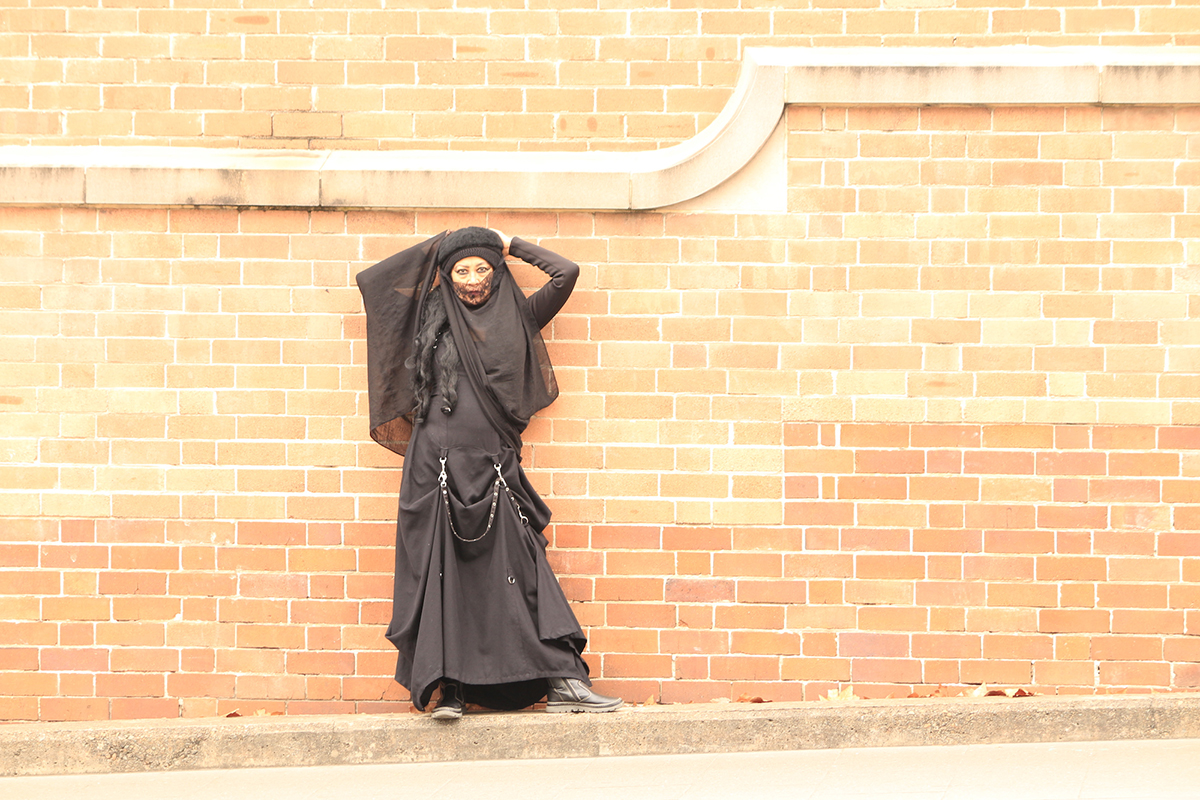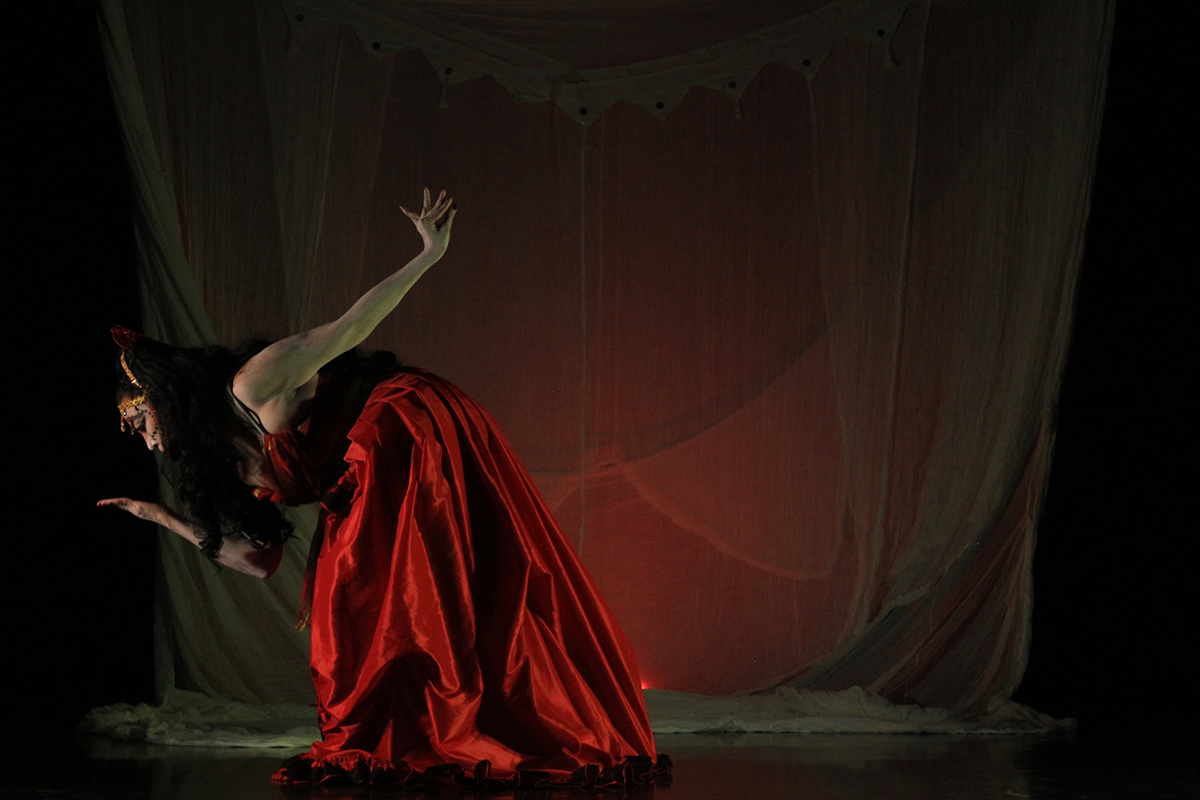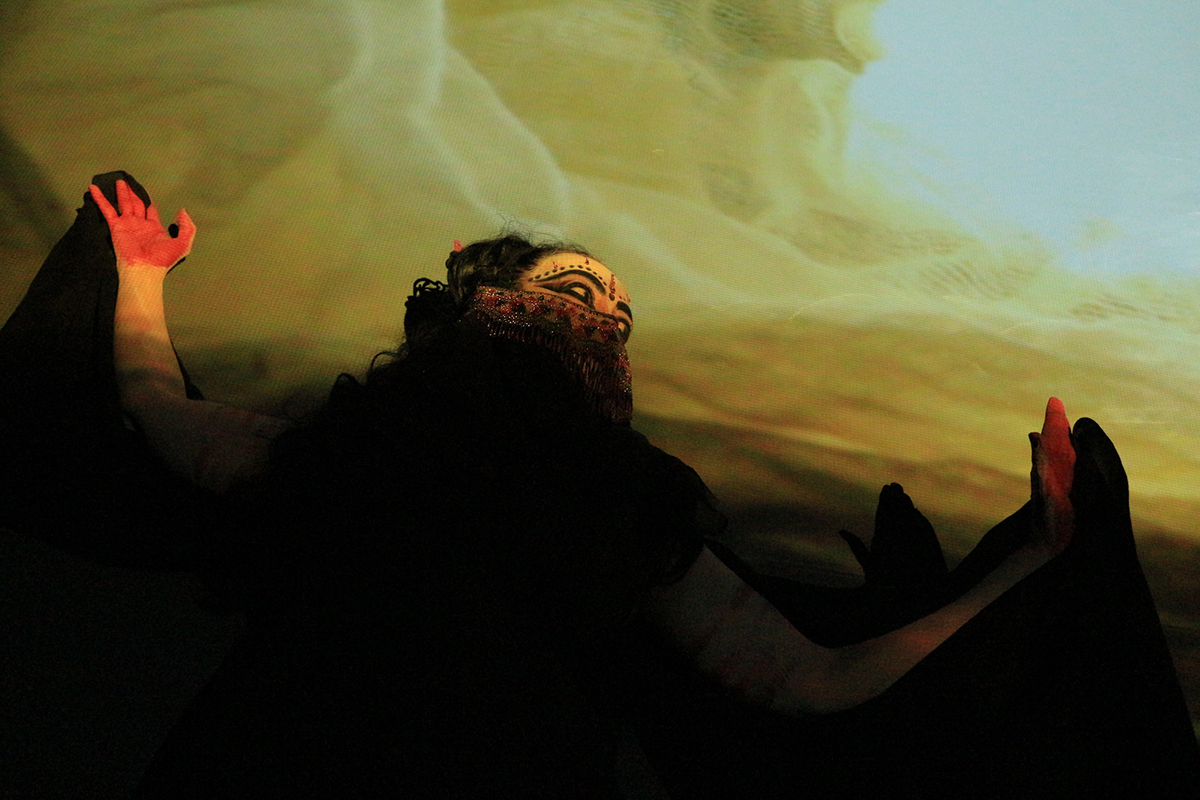
The goddess & the doctorate: Rakini Devi’s Urban Kali
Rakini Devi is a compelling presence — sometimes a very funny one — and a highly distinctive artist whose work stretches from the 1980s to the present in Indian classical dance, contemporary dance and performance, installation and collaborations with photographers, filmmakers and sound artists. Her latest performance, opening next week at Parramatta’s Riverside Theatres is central to the postgraduate degree, a Doctor of Creative Arts, which she is undertaking at the University of Wollongong and, she tells me in a phone interview, is near completion.
The University of Wollongong website explains, “The Doctor of Creative Arts is for those individuals with a track record of high level professional experience, who wish to extend their practice within a scholarly context… [It’s] based on presentation of creative work and supported by written documentation (dissertation) of the context and theories underpinning the work.” This interview with Rakini reveals her to be an ideal candidate for the degree. As she explains, her preoccupation with the seemingly terrifying Hindu goddess Kali has strong cultural and artistic roots and first manifested in her performance in the 1980s and then in subsequent works. Her extensive research into Kali could now be extended and deepened with university support.
Do you identify with the goddess Kali in any way?
It’s not so much that I identify with her but that she’s been a part of my history since I grew up in Kolkata. I’ve had a very hybrid upbringing — my mother was Burmese Buddhist, my dad is Indian, my uncle a Brahmin Hindu. I grew up very involved in all the different festivals, Hindu and Buddhist. I was educated in a Catholic convent with Irish nuns and after that at a college called Loreto, also run by Catholic nuns. I was always drawn to the spirituality of Catholic ritual and faithfully went on retreats with Jesuit priests and nuns. I was questioning spirituality from a very young age, asking my mother why she didn’t have to go to church and things like that. She said to me from very early on, “You choose when you grow up whichever direction you want to take. This is my faith and this is what I do.”
I was very attracted to the whole pantheon of gods and goddesses of Hinduism and to pujas (ritual offerings in the home) and the massive celebrations that happened in the cities, which I’ve replicated in my work. They involved huge, temporary roadside temples called pandals, which I’ve written about in my doctorate. They inspired me; they’re elaborate but the art is very naïve, very gaudy, sort of close to Mexican aesthetics, which I’m also drawn to.
The goddess Kali stands apart from the other gods and goddesses. She’s been regarded as a terrifying, inappropriately scary goddess compared with the others. In fact, in most other states in India, you won’t see images of Kali in homes; they’re too scared of her. She’s predominantly the main deity for Kolkata, if also made famous by being worshipped by bandits and thugs, like the Mexican Santa Maria. She’s always attracted me because of the wild iconography associated with her, which protests all of those things that are supposed to be decent and good and pure and conservative.
The British, of course, were horrified. They couldn’t understand the image of her standing naked in a cremation ground, garlanded with skulls, wearing a girdle of hands and holding a decapitated head. They didn’t understand that the decapitated head represents the seat of ego. The multitude of meanings in Kali iconography has fascinated me. Each part has a long history attached to it, including her tongue, which represents shame or defiance.
I’ve used the iconography of Kali over the past 27 years of my dance career in various forms: sometimes as a celebration of her in the classical form, at other times as an abstract form and in Urban Kali — my doctoral presentation — a culmination of all my past work, looking in particular at how I’ve used Kali over the past 10 years in my live art works.

Rakini Devi, Urban Kali, photo Karl Ford
Does Kali have a place in your classical Indian dance?
Kali didn’t play a specific role. I was more or less a personal devotee. Classical dance repertoire favours the more conventional gods and goddesses and the love between them. What it did teach me was how to use Hindu iconography, which is what classical Indian dance embodies. It grew out of the ritual temple dances and became what it is today. Indian classical dance has evolved through the years — it’s not the same as it was 2,000 years ago. It’s been revived, contemporised. It was only after I graduated and embarked upon working with my dance company in the 1990s and working with Australian dancers that I started to question how Kali might be relevant to my current life in Australia and to working in a cross-cultural sense. I started to look at different aspects and how I could represent this goddess I was so attracted to. I made my very first work in 1990 working from paintings of the goddess with three male dancers and it was called Graves, Slaves and Kalika — one of Kali’s names. It was an ambitious, naïve first production.
Did you attire yourself as Kali in that production?
I never try to replicate; I reference her. I use my own visual art and my body for the palette, taking from her elements that I want to exaggerate.
What kind of dance was involved in the performance?
I was working with graduates from WAAPA, using their contemporary dance training and basically ‘infusing’ them with Indian classical dance techniques. I never, ever attempt to transform a Western dancer into an Indian classical dancer; obviously that’s not possible. I used the strength of Western contemporary dancers, those things that really attracted me to the form — duets, contact, lifts, floor walk — when I studied contemporary dance for eight years.
Tell me about the subsequent works based around Kali.
After 1990 I had my company, the Kalika Dance Company in full swing. In 1995 I made one of my favourites, Kali Digambar. Digambar means “clad in space.” It was for a three-week season at PICA in Perth for four women, one male dancer and myself, an Indian classical singer and a didjeridu player. I performed as well as recited and sang in the orchestra. It was a work of full devotion to Kali and very special to me because I used sacred texts from hymns to Kali, with permission from Hindu priests who all attended the performance. I created a sort of sacred space with my own shrine I’d made from a replica of a roadside shrine. On film we had dancers in full Kali regalia immersing themselves in water. People thought it resembled something filmed in the 1930s. It was a quite beautiful work I’m still proud of.
In 2004, I made a work titled Kali Yuga at Parramatta Riverside in Sydney. I was teaching at the University of Western Sydney so I worked with 12 third-year students and five professional dancers all crammed into the Lennox theatre! I really wanted to play with the strength of numbers — 17 dancers masked in black with my characteristic painted red foreheads and third eye and again using a cross-cultural vocabulary. It was quite exciting.
Now, with Urban Kali, it’s like going full-circle. I had started in the 1980s doing a few solo works on Kali totally on my own and then I created my company, then worked with a big group, and now it’s down to me. I have to say it’s a bit scary.

Rakini Devi, Urban Kali, photo Karl Ford
Do aspects of Kali — the blood, the tongue or the four arms, or dancing on Shiva’s breast — play a part in Urban Kali?
It’s a very abstract work. I’m not literally enacting or dancing out anything in particular. But in my durational installations I’ve been using red wool coming from my mouth to represent the flow of blood or Kali’s tongue. But how can the body represent everything about her? To deal with that, I’ve separated the performance into three sections. The first is the blood ritual of Kali, represented in the unravelling of a 12-foot long red sari.
I started out thinking, I’m going to do the arms, then the head and the eyes. Then, I thought, no I don’t have to explain. It’s a work of art. It’s why I’m using film for aspects that would be ridiculous to try and show myself, that would look rather garish or kitsch if I tried to replicate them. These, like the wool as blood, appear as discrete movements of their own, which I’m not interacting with. It’s my concept translated into film and beautifully photgraphed and designed by Karl Ford.
There are two more sections, again very abstract, with me dancing in between the filmed sequences. In my gesturing, I reference all the iconographies of Kali, whether people recognise them or not. I like the mystery of performance.
Gestures with hands and fingers?
All in the hands; they’re all second nature to me because I’ve used them for so many years. When audiences give me feedback, they come up with all sorts of things they’ve seen that I never intended. That’s the most rewarding part of the performance. On the other hand, I hate it when people say, “Oh, here’s Rakini, she’s just going to do another little Indian classical dance.” Even though I’ve been grovelling on the ground, wearing a corset or whatever, they still reference me as the Indian dancer doing classical Indian dance, whereas what I’m doing bears no resemblance to the classical form.
For all the notions of darkness around Kali, it’s not a solely negative darkness, is it? It’s a necessary prelude to regeneration.
Absolutely. The darkness is the void but in Bengal where I come from, Kali is the mother. She is offering options. In Mexico people embrace death in their festivals and display skulls and skeletons — iconography that embraces death in a way it’s not in Christianity, or conservative Catholicism.
How do you translate this into feminist protest, which is part of your doctorate research around Kali?
In one of the film clips I reference female infanticide in India. It’s quite gruesome. In Melbourne, I had done a work called Disturbing Elements (2011), which was completely devoted to the issue and to suttee, the burning of widows. It’s part of the motivation behind everything I’ve done, not just during my doctoral research but long before I ever started academic study, referencing the injustices and misogynistic acts in India which I grew up with and which have now risen to scary proportions in India and elsewhere in the world. I feel Kali is perfect to use in protest against female shame.
Tell me about your doctoral research at the University of Wollongong?
It’s titled “Urban Kali, from sacred dance to secular performance,” and I’ll be submitting my final thesis towards the end of the year. I have only the final chapter to write.
And has this been a good experience?
It’s been a wonderful experience. I’ve had colleagues who’ve done a creative doctorate ask, “Aren’t you sick of it? Aren’t you stressed?” No, it’s a privilege to study. As an artist who’s struggled to do each and every project over the years, it’s such a luxury to be given three years to research a subject I’m absolutely passionate about. Mind you, having been steeped in this area of misogyny and atrocities for three years, I’m looking forward to the complete opposite. I say to [Professor] Sarah Miller, “I can’t wait to be funny again” and everyone agrees, “Yes, we can’t wait for you to be funny again.” But I never thought I would love research so much. The first year was traumatising just to get into the mode of academic writing, but once that was over I turned the corner, so my supervisor said, and I started to thoroughly enjoy the whole process.
It is a very isolating time. I’ve had wonderful guidance from supervisors, but it’s not something where you’re meeting people. It’s been a solitary journey but since most of my life has been about solitary research anyway it’s nothing different.
Has it given your body of work more body, more thought?
It has. And it’s changed my way of making work because I’m always cross-referencing — ‘is this relevant; is this not relevant?’ The editing process in making work changes as well. You’re not so precious about hanging on to things. When you’re younger, everything seems important. You’re emotionally attached to every single thing and you’re devastated if you can’t put everything into the work.
Will your research be valuable for artists and scholars?
I certainly hope so. There’s been a lot of writing about who Kali is and what she may be, but has her iconography been used in this way? No. That’s one of the things that’s called ‘a gap in the research.’
I’ve had people sneer at me, “Oh, why do you artists all feel you have to be academics?” And that’s not the case. I’ve been researching for over 20 years. Every work I made with dancers, I researched, I studied books, I made sure I cross-referenced. There’s a responsibility when you’re dealing with culture, you can’t just madly quote stuff and pick out what you fancy and just perform it.
Tell me about Karl Ford’s role in the collaboration on Urban Kali.
I’ve known Karl for about 15 years. The first time he created music for me was about 2003. He’s a sound artist and he’s also been doing film and photography. Karl and I share a passion — we’re both really nerdy horror movie fans. It’s a fantastic background for a Kali work. So we’ve had some intense working periods and then come home and watched a whole slew of gory slasher movies. I’ve always known that Karl’s sound was good but I never anticipated we’d be on the same page with film and photography. I love what’s happening on the film, but can I live up to it? That’s why I don’t want to interact with the film; I don’t want to be overshadowed by my own magnificence onscreen (LAUGHS).

Rakini Devi, Mexico City, 2014, photo Niña Yhared
–
FORM Dance Projects & Riverside Theatres, Urban Kali, creator, performer Rakini Devi, sound, film designer Karl Ford; Riverside Theatres, Parramatta, Sydney, 22-23 September
Watch a trailer for Urban Kali and see examples of Rakini Devi’s artworks and performances 2010-14.
Read about the University of Wollongong’s Doctor of Creative Arts degree.
Top image credit: Rakini Devi, Urban Kali, photo Karl Ford






